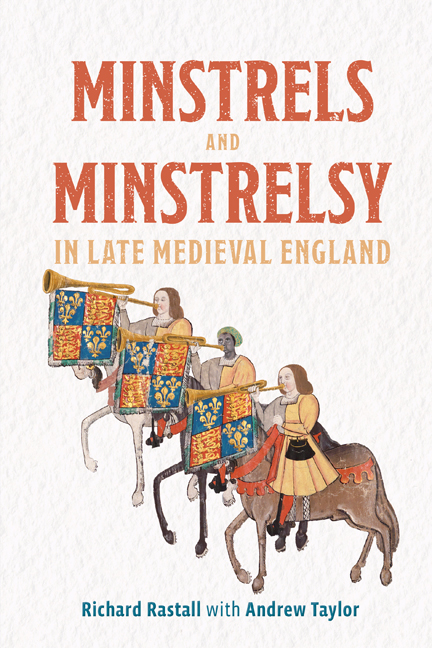Book contents
- Frontmatter
- Dedication
- Contents
- List of illustrations
- List of music examples
- List of abbreviations
- A note on references
- A note on money
- A note on dates
- Preface
- Acknowledgments
- Part I Minstrels and Minstrelsy in the Elite Households
- Part II Urban Minstrelsy
- Part III On the Road
- Part IV Minstrel Performance
- Envoi
- Bibliography
- Index
14 - Instruments and performers
Published online by Cambridge University Press: 09 January 2024
- Frontmatter
- Dedication
- Contents
- List of illustrations
- List of music examples
- List of abbreviations
- A note on references
- A note on money
- A note on dates
- Preface
- Acknowledgments
- Part I Minstrels and Minstrelsy in the Elite Households
- Part II Urban Minstrelsy
- Part III On the Road
- Part IV Minstrel Performance
- Envoi
- Bibliography
- Index
Summary
A few medieval instruments survive, and although most are very damaged and fragmentary it is still possible, given the necessary study, to learn about their original forms. Of those found and apparently made in England, there is a fourteenth- century straight trumpet in the Museum of London and a citole from the same century in the British Museum. Three late medieval celtic harps also survive, examples of the clarsach found in the Scottish royal accounts. The instruments recovered from the wreck of the Mary Rose, which sank in 1545, are probably later than the period discussed in this book but late medieval in form: two fiddles, a dulcina, three three-hole pipes (two showing evidence of continental manufacture) and fragments of a tabor.
Documentary evidence can sometimes support other kinds of information although it is not often helpful on its own. Much more useful is contemporary iconography, including illustrations of instruments in psalters and manuscripts of various literary works; several magnificent series of wood and stone carvings surviving in major churches at Beverley, Exeter, Lincoln, Manchester and Norwich, among others; and depictions of instrumentalists in the painted glass of some churches, such as the famous series in the Beauchamp Chapel in St Mary’s, Warwick.
Such depictions may be accurately drawn, but one should not assume that they can be taken at face value. Did the illustrator really know what an instrument looked like, and how accurately did he depict it? There are few criteria for this: the level of detail can be considered, and how consistent the depiction is with other illustrations, both by that artist and by others; and one can see how realistic is the depiction of the minstrel's hands on the instrument, whether the method of bowing or plucking strings is likely to be physically possible and comfortable, and so on. This builds up a general impression of the picture's trustworthiness or otherwise, and this in turn enables comparison with other depictions, similarly assessed. The impression gained is always subjective, but, given enough illustrations of a particular type of instrument, it may be strong enough to stand as evidence and be tested against surviving instruments.
- Type
- Chapter
- Information
- Minstrels and Minstrelsy in Late Medieval England , pp. 315 - 361Publisher: Boydell & BrewerPrint publication year: 2023

